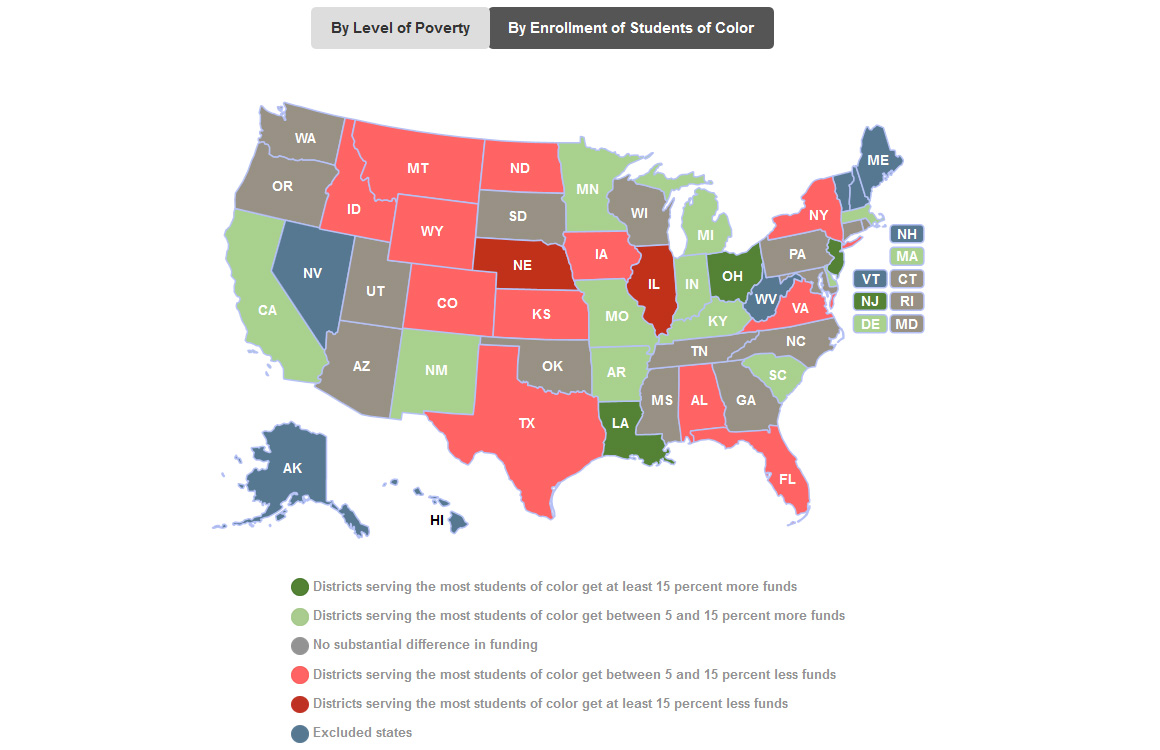
Share On Social!
U.S. school districts serving the largest populations of Black, Latino, or American Indian students get about $1,800 less per student in state and local funding than those serving the fewest students of color, according to Ivy Morgan and Ary Amerikaner of The Education Trust.
That means a district with 5,000 students faces a funding shortfall of $9 million per year.
And it gets worse.
This kind of funding shortfall creates an environment that doesn’t support academic progress among students of color, Amerikaner said.
For example, the 2019 Nation’s Report Cards for math and reading in grades 4 and 8 show achievement diverged from 2003-2009 and 2009-2019 for Latino and all students. Students scoring in the 10th percentile in 2019 are making fewer gains than they were in 2003-2009. Those scoring in the 90th percentile were stagnating in 2003-2009, and now are making gains in 2019.
“[These] results provide more evidence of how deeply we shortchange students from low-income families and Black and Latino students,” Amerikaner said. “While the nation has witnessed significant progress for all groups of students over the last 30 years and many of our largest urban school districts are moving steadily to raise student achievement, we have miles to go to close opportunity gaps and the achievement gaps they create.”
Investment in early childhood education is critical to close the academic and health gap.
Gaps in Funding
High quality early childhood education is essential to getting a strong start in life, according to The Education Trust.
 The Education Trust analyzed school funding equity for each U.S. state. You can look at how your state compares to others by using their interactive map.
The Education Trust analyzed school funding equity for each U.S. state. You can look at how your state compares to others by using their interactive map.
You can also sort map data by the enrollment of students of color or by level of poverty.
When users click on their home state, they can read more about the state of funding equity in that specific state.
This includes information such as:
- How the state contributes to school funding compares to other states
- A comparison of the amount of funding given to the states highest and lowest poverty districts
- What the funding gap looks like for students of color
- Percentages of students in each race/ethnicity and income status
Diverse Preschool Educators
Amerikaner called on policymakers to address other inequities in schools.
The Education Trust’s advocacy guide encourages schools and districts to address inequities in access to strong teachers between and within schools.
What we know about recruiting, equitably assigning, and retaining strong teachers for school improvement according to Ed Trust:
- Teachers matter. Students with strong teachers make significant learning gains. States tend to use a number of proxies including effectiveness, observation ratings, years of experience, or expertise in a subject and/or grade band to determine what a strong teacher is.
- There are inequities in access to strong teachers between schools and even within schools.
- These patterns are not inevitable. For example, teachers are, on average, almost twice as likely to leave a high-poverty school as a low-poverty school. Yet this difference nearly disappears when teachers are satisfied with the leadership and staff cohesion at their school.
- Teacher diversity matters. Students of color are far less likely than their White peers to encounter a teacher who looks like them. Teacher diversity is important for all students, including White students, who undoubtedly benefit from the opportunity to learn from teachers of other races and ethnicities.
- Money matters, but it alone is not enough. Research shows that financial incentives may help schools retain strong and diverse teachers. But the effects fade after those incentives stop.
- School, district, and state leaders have critical responsibilities related to the recruitment and placement, development and support, and retention of strong and diverse teachers.
This advocacy guide also includes detailed questions to ask to school and district leaders.
As a result of this extensive report, expectations are high.
How Can We Close The Gap in School?
Amerikaner called on national, state, and local leaders to take their research seriously and take action to address persistent inequities in and out of the classroom.
 “Until we adopt policies and make investments that center the needs of historically underserved students, including students from low-income families, Black students, and Latino students, it’s unrealistic to expect these gaps to close,” she said. “While the [Nation’s Report Card] results are disappointing, we’ve seen across states and districts that progress is possible.”
“Until we adopt policies and make investments that center the needs of historically underserved students, including students from low-income families, Black students, and Latino students, it’s unrealistic to expect these gaps to close,” she said. “While the [Nation’s Report Card] results are disappointing, we’ve seen across states and districts that progress is possible.”
Denver is a great example of how school districts are listening to the people and addressing the inequities in access.
Several districts have seen promising results from implementing teacher leadership models.
For example, Denver Public Schools (DPS), one of the fastest-improving large districts in the country, created a program whereby lead teachers coach and develop a team of their colleagues. The district allocated more funding to high-need schools to implement these teaching teams.
This is why our Salud Hero, Dr. Rogelio Saenz, conducts research and data analysis on the Latino population. He wants to give context and evidence for policymakers so that they can help respond to the challenges that Latinos face.
Saenz said it takes all sectors working together.
“Bringing together academics, nonprofits, policymakers and collaborating for the betterment of the community is what keeps driving my research,” he said.
Explore More:
EducationBy The Numbers
142
Percent
Expected rise in Latino cancer cases in coming years



